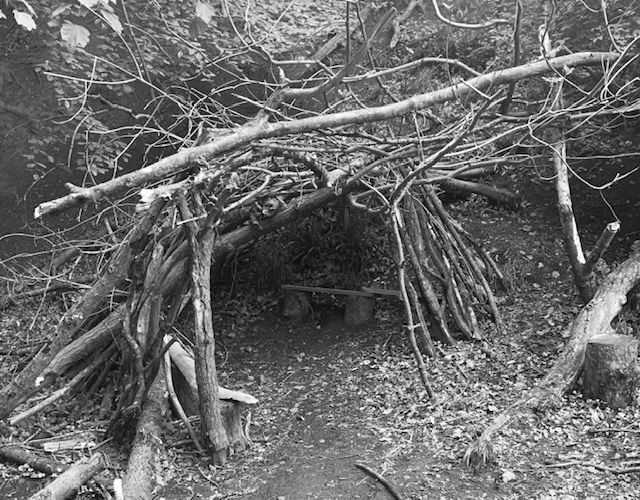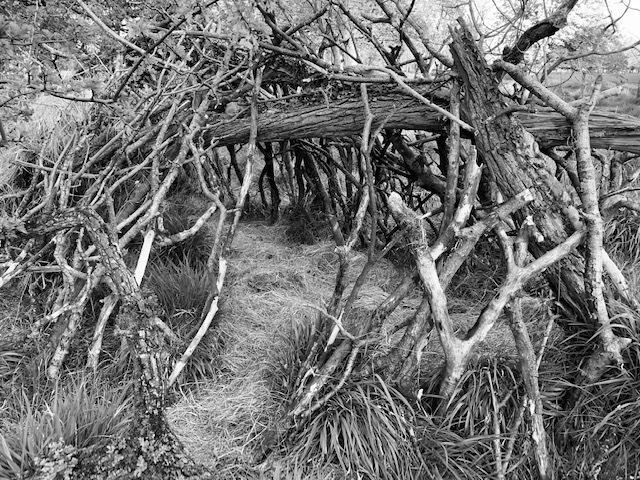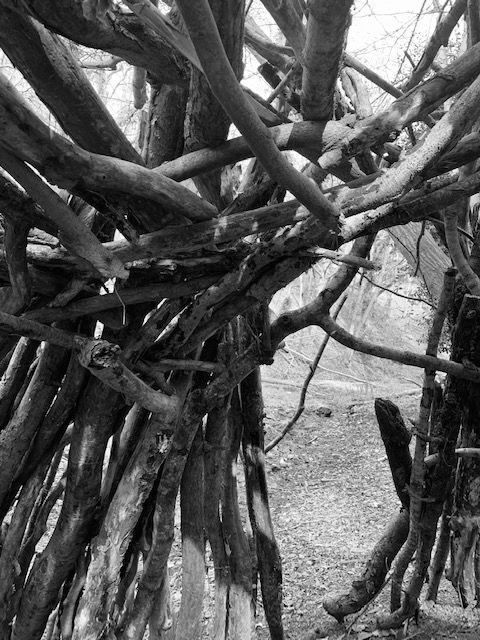HABITATS OF COMPOSITION: THE NATURE OF THE COMMONS

 Pamela Whitaker, MA, PhD
Pamela Whitaker, MA, PhD
Course Director, MSc Art Psychotherapy, Ulster University, Belfast School of Art, Northern Ireland
Abstract
This is an article about land art that constructs habitats of refuge or survival shelters. The art of constructing forest sanctuaries, as a form of social media, is a resourcing of found materials transformed into personal and social places of significance. Amidst COVID-19 restrictions, nature became everyone’s place to be and public parks were an essential common place for combining and finding a place apart to come together. What emerged in the forests of Phoenix Park, Dublin, was the construction of landmarks for protection and solace. As bushcraft and public artforms, these dens act as declarations of personal security and social constructions, occupying both a boundary and an invitation. They are landmarks for solitary pursuits and social encounters; transformative locations for introspection and the communal sharing of a forest.
Keywords: commons, land art, the art of walking, public art
Sheltering in the forest: The nature of the commons

Figure 1. Whitaker, P. (2020). Habitat 1. [Photograph]. Dublin, Ireland: Personal Collection.
Whereas found objects are a familiar media for art making and art therapy [6,17], found artworks and installations can inspire an investigation into the nature of the commonplace as artistic milieu [23]. This is a contemplation of how the personal finds its place in a public context of shared location. A commons is public land belonging to everyone—it is open access, open plan and open to interpretation. I propose the commons can be a studio for the making of social connection, conviviality and the gathering of observance. Within localities, a commons is a meeting place that traditionally combines culture and natural resources for public benefit [18]. Whether a park, community garden, greenway or nature walk, the commons offers the capacity for making an impression. The sharing of landscape is relevant to public concerns, the nature of cohabitation, and what we make of living together [18]. Spatiality in a commons can be navigated both on a personal and collective scale as human geography made significant by the people who engage with it as a socially engaged landscape.
The commons as public park is there for the making—place making is integral to experiencing the commons as an archive of landscape that is environmentally designed by people and ecology as co-creators. A public park is there for everyone, a location that can be re-formed by art making, and a declaration of how to create with materials that are readily available. The legacy of a commons has both a natural history and social history. It is a place of ecology within a particular locality, with a legacy of land use and social occupation. It is a form of bio-regionalism, a network of nature and people in a defined life-place. COVID-19 brought into awareness a defined regionality, our particular geography and nearby environments facilitating contact between people and nature. This developed an approach to experiential forms of community building through regional consciousness [8], whereby people walked routes of investigation into local nature surroundings. A city park offered the possibility of becoming a bioregional studio with “the potential to address human-environment connections… and resilient practices and patters of urban living” [8]. Bioregionalism encourages a recognition of nature as a life companion, an ecology that inspires an activism of participation and the representation of vernacular cultures, or what can be made in communities of geography [8].

Figure 2. Whitaker, P. (2020). Habitat 2. [Photograph]. Dublin, Ireland: Personal Collection.
A commons is a bioregion not governed by private interests, but rather facilitates a “citizenship of strangers” [4, p. 684] who collectively perform random acts of vernacular local culture [16]. Such expression of locality can be individually created, but collectively they designate a character of place that is both context dependent yet with constant variation [16]. The commons, rather than a regulated or prescriptive place, should facilitate diversity both in terms of nature and cultural free association.
“As soon as we begin to reduce plurality, as soon as we begin to ‘homogenise’ and ‘purify’ public spaces by prescribing and policing what can be done and said in such spaces, by prescribing…what is ‘proper’ and what is ‘deviant’, we begin to eradicate the very conditions under which action is possible and freedom can disappear” [4, p. 689].
My interest in celebrating the commons was informed by the botanical intervention practice of Oliver Kellhammer [13] and his proposal for open source landscaping inspired by relational aesthetics [7]. Relational aesthetics can also encompass an approach to collaborative art making whereby people and nature form an artistic alliance. Kellhammer’s art is the cultivation of biodiversity habitats and the re-wilding of civilised spaces. He appropriates land for public art that is ecologically determined to intervene and transform. His interventions are reparative as they involve forming a system of relationships with nature as a collaborator. The construction of a den, as a land art structure, is a crafting of nature that re-purposes a fallen tree into architecture. It is the making of a landmark that maps locations of artistry. The culture of the commons means that each constructed shelter is an artwork of connection, that has significance for both the person (or people) who made it, and for those who found it along their pathway. The network of dens made in Phoenix Park during COVID-19 social restrictions are creations that lead us into places that are at the same time both familiar and unknown. As forms of social media they offer the creation of shared content, using found environmental materials to shape life places in natural surroundings. The shelters as artforms also suggest the significance of architecture as “demarcation, enframement, containment in order for qualities as such to emerge, to live, and to induce sensation. Architecture is the most elementary binding or containment of forces, the conditions under which qualities can live their own life through the constitution of territory” [12, p. 16].

Figure 3. Whitaker, P. (2020). Habitat 3. [Photograph]. Dublin, Ireland: Personal Collection.
The art of walking
Sullivan [22] associates mapping with multiplicity, in reference to the rhizome as a botanical model of cartography in the philosophy of Deleuze and Guattari [11]. The rhizome is a network of growth that leads in many directions and signifies the “in between” as lines of growth. The locations of the shelters are dispersed, but connected by way of new pathways drawn into the ground by both makers and viewers. As lines of walking they form a rhizomatic representation that disrupts predictable or pre-determined walking routes. The art of walking generates an outdoor studio at the place where the shelter is made. “A rhizome, as a map, is to do with experimentation. It does not trace something that came before…rather it actively creates the terrain it maps—setting out the coordination points for worlds-in-progress, for subjectivities to come.” [22, p. 35]. The dens as landmarks designate a route of travel that has been improvised and then followed as a desired line of connectivity. This is an expression of nomadic subjectivity investigating the nature of place in parallel with the subjectivity of becoming. In this way, “environmental arts can be understood as an ecological form of personalization based on the sustainable and supportive human interaction with the natural world” [15, p. 31].
The term psychogeography is a practice of wandering where found locations are a form of inquiry investigating the psychology of place and specific effects of a geographical environment upon the inhabitant [19]. Guy Debord defined psychogeography in relation to what is found by way of chance and sensory tracking—a mapping of territories that unites self-observation in tandem with field research and happenstance [10]. Each shelter maker intuitively finds a place where they wish to build. The route of their travels is not pre-determined so much as improvised through path making and producing an impromptu studio that conjures an inclination to create and find respite. “The walk, the walker and the space walked constitute a unified field of phenomena in which characteristics of the place and its life forms have potential significance” [1, p. 125].
As a potential home in nature [3], the shelters act as domesticated artworks that mediate proximity and distance, and as shared landmarks that make a scene in public. These nature informed constructions have boundaries that designate a territory, but do not exclude social curiosities, so they are simultaneously autobiographical and communal. “A territory is the delimitations of a milieu…it is an external synthesis, a bricolage of geographical elements, environmental characteristics, material features, shifted and reorganized fragments…that create both an inside, an outside, a passage from the one to the other, and a space that is annexed” [12, p. 47].
The den hideouts became viral, proliferating different areas of the park. This was an experiencing of resonance, and the repetition of self-differentiating structures, which moved sensation and affects across terrains [22]. As both personal and public artforms, these structures compose a sense of security and steadfastness that intertwine personal and social relationships. They are assembled with an ethos of civic spirit and togetherness, despite being made while people were at a social distance. The significance of the dens is their multiplier effect; each is a distinct creation and design that resonates with the many, and a refuge where people unknown to each other forge a connection.
The term psychogeography denotes chance situations that make us reconsider the meaning and potential of our whereabouts as transforming contexts [10]. Haptic knowledge can be derived from these discursive physical experiences, where one location is a matrix of space that transgresses a particular use or singular interpretation. Being in touch with the assembling of land art is an aesthetic response to nature [2] and a form of arts-based inquiry. Foucault applied the term heterotopia in relation to spaces that are plural, other, and altering [21]. The term heterotopia refers to inhabiting a place within a place. The materials of these handmade shelters are juxtaposed to create the emergence of a new enclave that is different in character to its surroundings.
“The rite of ‘passage’, the stepping and walking away from, across a transition zone, towards another place, is a crucial spatial and psychologically metaphoric process, involving the approach to, standing at and crossing a potent threshold, entering a place of new identity, responsibilities, roles and potential, symbolically achieved by walking between representations” [1, p. 142].
As place-based and nature informed collective actions, the dens are there for everyone. One den habitat inspires the making of many, and an artist collective of makers (unknown to each other) is forged as a trending of like-minded endeavours takes place. These created habitats can be mapped into routes of inquiry and an aesthetics of connectivity. The art of walking encounters landscape in an immediate way, and the dens bring people together as a community of passers-by, occupying them both physically and semantically, through associations to meaning. The shelters can be mapped as routes of travel through the park that are also self-made paths that create a personal and collective cartography.
“The physical events of the walking experience [are] drawing lines of encounter. It is this collision of forces—anatomy, materials and physical location—that generate spontaneous constructions of art in place. Routes are experiences, investigations of surroundings, and dimensions of space. They are both personal and social movements” [23].
The commons in the form of a public park, is there for everyone. Its natural materials can be utilised to facilitate both a regional identity and the making of a personal sanctuary. The ownership of a den hideaway is ultimately shared, with the artisan crafting not only an individual creation, but a creation with multiple effects. As a kind of home-place, the den is a crafting of found materials into a composition that is also there as a home-place for others. It reflects the ethos of the commons, as a resource for democratic participation. The significance of art and participation outdoors can also be related to public pedagogy, “an educational intervention enacted in the interest of the public quality of spaces and places and the public quality of human togetherness” [4, p. 684]. Richard Sennett [20] proposes the politics of cooperation can be enhanced through rituals, which include the pleasure and altruism of giving through civic participation. Public art making can be a commitment to community and everyday diplomacy in relation to the sharing of the commons for re-creation and reconstruction [20]. The fallen branches in a forest, perhaps the aftermath of a storm, are the materials for shelters of support and re-building, these found materials construct a metaphor that ignites the hope of re-purposing [17]. As a support structure [9] the dens are scaffolding which hold up what has been broken. The balance is found as the branches lean against each through mutual support. The strength of the structure is through interlacing different variations of branches (props) which reconfigure individual parts into a whole. When found along a forest pathway, it is a structure that can be added to, and acts as a framework and prototype for others to re-design in their own way.

Figure 4. Whitaker, P. (2020). Habitat 4. [Photograph]. Dublin, Ireland: Personal Collection.
The production of becoming
As formations of artistic production on public land, the dens can be occupied by many, and represent landmarks of both personal and collective becoming. Each person who enters may adapt a found shelter for their own aims as a temporary autonomous zone [19]. However, there is an accumulation of artistic contributions, so the habitat is ultimately a collaborative venture, with new potentials formed whenever anybody adds their own branches to the mix. These material and design contributions accumulate layers of both “interference” and alliance [5]. The den is a scaffolding of support that adds emergent properties for those who contribute to what they find. These many heterogenous intentions do not reach a conclusion or finishing point, but instead represent multiple forms of becoming. The den is a gathering together of contingency, a metaphor for survival in a forest, demarcating a boundary that is also an interface. In the forest park, people can venture instinctively in search of a place to gather themselves. The dens are not a destination, but a surprise encounter with artistry that reinvents the materials of the forest as public art forms. These are sculptures of human potential, new thresholds of occupation in a landscape that acts as a trajectory of emergence [5]. As a practice of everyday life within a pandemic, the crafting of these life places brings home the idea of composing oneself by way of retreat and through a reimagining of one’s territory.
Bonta and Protevi [5] suggest that territories are expressive markers producing “the feeling of being at home.” (p. 158). Territories as milieus, are composed from meaningful materials that both deterritorialize and reterritorialize through movements of both escape and capture. Each shelter is a signature piece that is added to by others constituting a shared space. “Our identities are always in negotiation, always in the process of being formed and re-formed through our encounters with others” [14, p. 154]. These makeshift habitats are a curation of art within the landscape, that are contact zones for the orientation of multiple agencies. Perhaps, the shelters are a form of graffiti which encourage the freedom of unregulated making, as a form of civil disobedience that undermines meta-narratives of park designs. As a form of active citizenship in the commons, the art of the people conjures place for subjectivities in the making.

Figure 5. Whitaker, P. (2020). Habitat 5. [Photograph]. Dublin, Ireland: Personal Collection.
Acknowledgements
I acknowledge the support of Justin Magee, Research Director, Belfast School of Art, Ulster University and his encouragement to write about my encounters with the shelters I found during my walks in Phoenix Park, Dublin during COVID-19 lockdowns in Ireland. In particular his contribution to understanding these shelters as a form of social media (the social use of foraged branches as art media) was intriguing and informed my appreciation of their multiplier effects as public engagements with land art. I am also grateful to Alexander Kopytin for asking me to write an article, as it was an opportunity to spend further time walking and engaging with the den shelters as landmarks that propagate artistic agency on a public scale.
References
- A’Court, B. (2017). The art of mindful walking in earth-based art therapy. In Alexander Kopytin & Madeline Rugh (Eds.), Environmental expressive therapies: Nature-assisted theory and practice (pp. 123-161). New York: Routledge.
- Atkins, S., & Snyder, M. (2018). Nature-based expressive arts therapy: Integrating the expressive arts and ecotherapy. London: Jessica Kingsley Publishers.
- Berger, R. (2008). Building a home in nature: An innovative framework for practice. Journal of Humanistic Psychology, 48(2), 264-279.
- Biesta, G. (2012). Becoming public: Public pedagogy, citizenship and the public sphere. Social and Cultural Geography, 13(7), 683-697.
- Bonta, M., & Protevi, J. (2004). Deleuze and geophilosophy: A guide and glossary. Edinburgh: Edinburgh University Press.
- Brooker, J. (2010). Found objects in art therapy. International Journal of Art Therapy, 15(1), 25-35.
- Bourriaud, N. (2002). Relational aesthetics. Dijon: Les Presses du reel.
- Church, S. (2014). Exploring urban bioregionalism: A synthesis of literature on urban nature and sustainable patterns of living, Sapiens, 7(1) https://journals.openedition.org/sapiens/1691.
- Condorelli, C. (2014) Support structures. Berlin: Sternberg Press.
- Coverley, M. (2010) Psychogeography. Harpenden, Hertfordshire: Pocket Essentials.
- Deleuze, G. & Guattari, F. (2004) A thousand plateaus: Capitalism and schizophrenia. London: Continuum Press.
- Grosz, E. (2008) Chaos, territory, art: Deleuze and the framing of the Earth. New York: Columbia University Press.
- Kellhammer, O. (2020). Botanical Interventions: Open source landscape and community repair. http://oliverk.org/publications/non-fiction/botanical-interventions-open-source-landscape-and-community-repair-essay.
- Kester, G. (2004). Conversation pieces: Communication and communication in modern art. Los Angeles: University of California Press.
- Kopytin, A. (2017). Environmental and ecological expressive therapies: The emerging conceptual framework for practice. In Alexander Kopytin & Madeline Rugh (Eds.), Environmental expressive therapies: Nature-assisted theory and practice (pp. 23-48). New York: Routledge.
- Mackey, C. (2010). Random acts of culture. Toronto: Between the Lines.
- Moon, C.H. (2010). A history of materials and media in art therapy. In C.H. Moon (Ed.), Materials and media in art therapy: Critical understandings of diverse artistic vocabularies (pp. 3-49). New York: Routledge.
- Moss, T. (2014). Spatiality of the commons. International Journal of the Commons. 8(2), 457-471.
- O’Rourke, K. (2013). Walking and mapping: Artists as cartographers. Cambridge, Massachusetts: The MIT Press.
- Sennett, R. (2012). Together: The rituals, pleasures and politics of cooperation. London: Allen Books.
- Sudradjat, I. (2012) Foucault, the other spaces, and human behaviour. Procedia-Social and Behavioral Sciences. 36, 28-34.
- Sullivan, S. (2006). Art encounters: Deleuze and Guattari. New York: Palgrave.
- Whitaker, P. (2021). The art of walking: Composing landmarks, performing territory [Manuscript submitted for publication]. In D. Wong & R. Lay (Eds.), Found objects in art therapy: Materials and process. London: Jessica Kingsley Publishers.
Reference for citations
Whitaker, P. (2021). Habitats of composition: The nature of the commons. Ecopoiesis: Eco-Human Theory and Practice, 2(1). [open access internet journal]. – URL: http://en.ecopoiesis.ru (d/m/y)
DOI: 10.24412/2713-184X-2021-1-26-32

